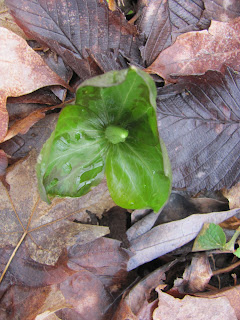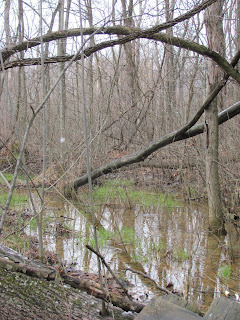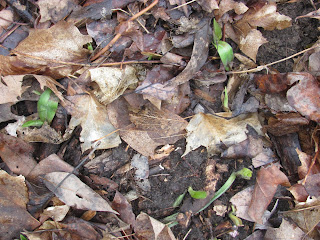Waiting, Waiting...
Ouabache Trails Park
Knox County, Indiana
March 1, 2013
Where I live, so many people do not
like winter, and complain about it all the way through. But, I love
winter – the dark skeletons of trees against a fresh coating of
snow, the steel blue sky, seeing the lay of the land, the calm and
quietude, and that nip in the air that keeps me feeling awake and
alive. I appreciate that, for a whole season, I will not feel hot.
I hear many people say, “I can't wait
'til spring” or “Spring can't come soon enough for me!” Or,
they pose a question: “I can't wait for spring, can you?” I
don't think they like my answer. It's not the agreement they expect.
The answer is: I can wait. All in
good time. It will be here soon enough. It will be here when it's
here. Frankly, spring means the start of an awful lot more work for
me, and I am not ready yet. I can put it off longer. I have much
yet to do before then. Let me catch my breath.
Wild Hydrangea
I do love, though, to go into the woods
and find signs of spring, those latent forms almost hidden. While
others are complaining that spring can't come soon enough, I'm out
there discovering that it is, indeed, here. In fact, it has been
here all winter, and winter has been here all summer. It's all in
the cycle.
On the first day of March, I went to
the woods at Ouabache Trails Park to explore, to look beside old
logs, into creeks, under the blanket of brown leaves, on the sides of
trees, and overhead. In the distance, Barred Owls called to one
another, one starting with the classic call
“Whoo...whoo...whoo...whoo..WHAAooo...” and another answering in
a more highly pitched voice, in some variation. Red-bellied
Woodpeckers called in their loud, almost tropical-sounding voices. I
heard the repeated terse, nasal calls of the White-breasted
Nuthatches. The late winter acrid perfume of decaying leaves was
carried on the damp breezes.
I went to the wetland first, and the
creek that meanders flatly through it. The deer had been there
earlier in the morning, pressing hooves into the mud while sipping
morning water.
Swollen green flower buds dotted the
numerous Spicebush, which last fall were loaded with bright crimson
berries.
Red-Headed Woodpeckers, also numerous
in the wetland, were active among the stands of dead trees, hammering
the wood for insects.
During a very cold day such as this,
frogs were burrowed in the mud under standing pools of water, saving
energy by greatly slowing their metabolism. On the occasional late
winter/early spring warm day, calls of tiny Chorus Frogs will sound
here and there from the water, voices like a thumbnail being rubbed
across the teeth of a comb.
Crawdads and other burrowing critters
have been busy.
A cache of Tulip Tree seeds awaiting
possible germination and a bag of spider eggs were protected within
the same hole in this rotten old log.
On into the woods …
Fungi were coming back to freshness
with this season's wetness.
The Pileated Woodpeckers have been
carving out their giant oval holes, searching for delectable ants in
the dead wood.
Ebony Spleenwort
Ebony Spleenwort and other ferns were
waking up, one species at a time.
Mosses were turning brightest green, in
time for St. Patrick's Day. Many were sprouting delicate sporophytes
on hair-thin threads, curving out toward the almost-spring moist air.
An Ash seed was lodged into the moss, ready as part of a meal for a
chipmunk.
New seedlings were taking advantage of
any suitable place to sprout, from seed deposited last year by wind
or wildlife.
Squirrels have been busy storing up
their reserves with acorns and other seeds in preparation for the
high-energy season of territorial protection, mating, nest-building
and raising young.
Bladdernut seed pods
Papery brown pods of the Bladdernut
shrubs fell to the forest floor last autumn. Eventually, they rotted
enough to open and release their seeds to the fertile floor.
Some green plants were beginning to
push through the wet brown leaf layer. Some became food for wildlife
craving green food after a long winter.
White Stonecrop
In Winter is Spring and Summer, and in
Summer is Autumn and Winter. Everything waits, but something is
always coming for the, in its own good time.



















































